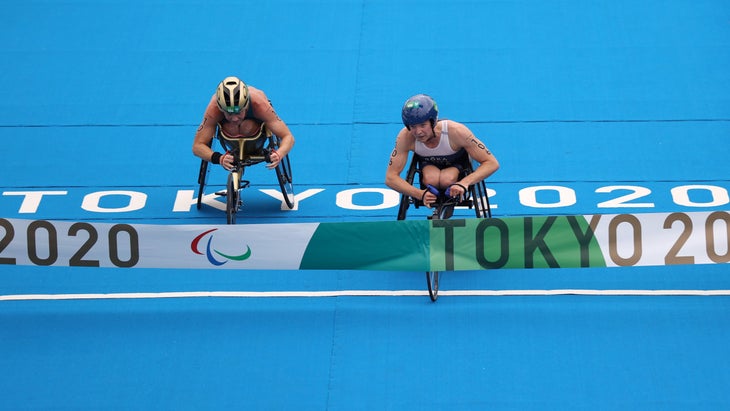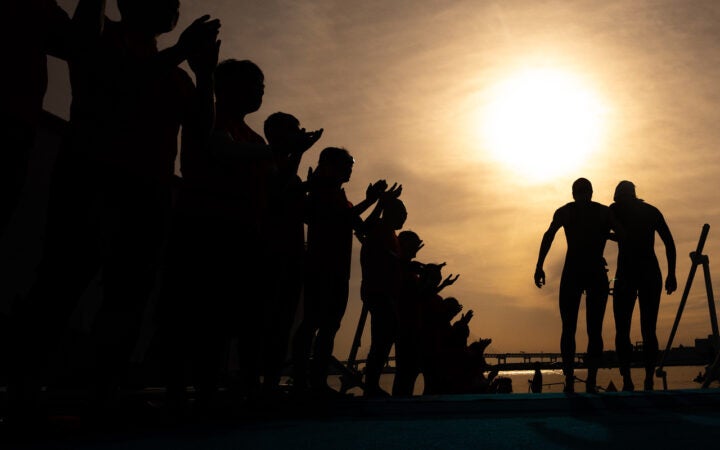New perk! Get after it with local recommendations just for you. Discover nearby events, routes out your door, and hidden gems when you sign up for the Local Running Drop.
Paratriathlon is one of the fastest-growing segments of triathlon, and has grown exponentially since Jim MacLaren became the first athlete with a disability to finish an Ironman in 1989. Still, as the world prepares for the 2024 Paralympic Games in Paris, paratriathlon remains one of the most widely misunderstood classifications in the sport.
To better understand paratriathlon ahead of the Paralympics, the High Performance Staff at USA Triathlon answered the most common questions about paratriathlon.
Tune In: The paratriathlon races in the Paralympics will take place Sunday, Sep. 1. A select number of Paralympic events will be airing on CNBC, USA Network, and NBC, while all 22 Paralympic events will be available to stream on Peacock.
What is Paratriathlon?
Simply put, paratriathlon is a category within a triathlon race for athletes with certain physical disabilities. As with other race categories (professional and elite; men and women; various age groups; Athena and Clydesdale), paratriathlon categories offer athletes the chance to compete against people who are physically similar. This allows for triathlon to be inclusive of athletes with all abilities as well as address any accommodations that need to be made for a disability, like a blind athlete who requires a guide or an amputee athlete who wears a prosthetic device.
Within paratriathlon, there are nine sport classes competing in six medal events:
PTWC refers to wheelchair users, who use a recumbent handcycle on the bike course and a racing wheelchair on the run segment. Both PTWC classes compete in the same PTWC medal event in the Paralympics.
PTWC1: Most impaired wheelchair users.
PTWC2: Least impaired wheelchair users.
PT categories refer to those with physical impairments, such as athletes with impaired range of movement or amputee athletes who use approved prostheses (for example, a specialty prosthetic leg known as a running blade) or other supportive devices during the bike and run segments.
PTS2: Severe impairments.
PTS3: Significant impairments.
PTS4: Moderate impairments.
PTS5: Mild impairments.
VI categories refer to those who race with visual impairments. When racing in this category, one guide from the same nationality and gender is mandatory. During the race, they must ride a tandem bike during the bike segment. All VI classes compete in the PTVI medal event at the Paralympics
PTVI1: Athletes who are totally blind, from no light perception in either eye to some light perception.
PTVI2: Severe, partially-sighted athletes.
PTVI3: Less severe partially-sighted athletes.
It should be noted that in the PTVI and PTWC categories, when they compete in one class in the Paralympics or world championship events a “factoring” system is used—ie. a head start is given to athletes with more severe impairments, based on a classification system.

Why are so many different classifications needed in paratriathlon?
Different impairments impact an athlete’s performance in different ways. The classification system exists to provide a competitive structure that minimizes the impact of any given impairment on the outcome of the competition—by placing athletes with similar activity limitations in triathlon against each other.
The classification system is specific to each Paralympic sport, because impairments impact the ability to perform different sports in different ways (think paratriathlon vs. wheelchair basketball vs. alpine skiing). An athlete’s classification also takes into account all their impairments and attempts to put them in the appropriate category, even though athletes’ specific disabilities may vary within the classification.
Why are some disabilities under the paratriathlon umbrella, but not others, like athletes who are deaf?
Each sport’s international federation (in this case, World Triathlon) is responsible for creating its own classification system, sport classes (including which impairment types are eligible), and minimum impairment criteria for their sport. USA Triathlon follows the lead of World Triathlon for its paratriathlon-specific rules at national championships and development events, but USA Triathlon also offers physically challenged open divisions, which are inclusive of all athletes who have an impairment and need rule modifications to compete.
If an athlete has a disability, does that automatically mean they have to race in the paratriathlon category?
No. If an athlete is able to participate in the non-paratriathlon age-group division without additional modifications, and wishes to do so, they can. USA Triathlon educates race directors about this option, so that if they see a paratriathlete registered in an age-group division, they are instructed to ask the athlete first before moving them into a paratriathlon category.
USA Triathlon competitive rules do limit certain equipment in age-group racing. If an athlete uses a racing chair, handcycle, or tandem bike, or requires any additional equipment modifications (such as an adaptive push team), they must race in a paratriathlon division (if they meet classification criteria) or a physically challenged open division.
How does an athlete qualify for their paratriathlon category?
All athletes who are interested in racing in paratriathlon at the national level need to attend an event in the U.S. where classification is being offered. The USA national classification rules and regulations are similar to the World Triathlon para classification rules and regulations.
The idea behind the U.S. having a national level classification system is so that athletes can first be seen by a USA classification panel and can be placed into the correct sport class (PTWC, PTS2-5, or PTVI). This will help alleviate any stress or uncertainty when an athlete wishes to compete in World Triathlon level races, and then must be seen by an international classification panel. The classification panel attempts to consider all modifications, disabilities, and impairments before assigning a classification.
How it works:
- Register for an event where classification is being offered (such as the USA Paratriathlon National Championships).
- Have a specific classification appointment time assigned by USA Triathlon in advance of the event.
- See your doctor and have them fill out specific paperwork as it relates to your impairment.
- Bring these documents and all of your racing equipment to your appointment, where you will undergo specific range of motion and muscle power tests.
- Classifiers will assign you a provisional sport class to race in the event.
- Classifiers will then observe you in competition during the race.
- After observation, they will confirm your sport class.
To compete internationally, there is a similar process with a World Triathlon panel, with World Triathlon offering a few classification opportunities each year.
Do all paratriathlon categories race at the same time, or in separate waves?
Generally, each medal event has its own wave. Each race course is different, and safety can dictate the time between waves. PTWC (wheelchair) and PTVI (visually impaired) divisions use a staggered head start system, called factoring, so that athletes with different limitations can fairly compete against each other in the same medal event.
PTVI1 and PTWC1 (more severe impairment/vision loss) get a head start over their competitors (PTVI 2/3 and PTWC2), so that the first across the line is the winner of the race for all of PTVI or PTWC. The specific staggered start times vary and are reviewed by World Triathlon every two years.

What should we expect to see at the Paralympic Games in Paris?
At the 2024 Paralympic Games, paratriathletes will cover a 750-meter swim, a non-drafting 20-kilometer bike, and a 5k run. All races will be held in the heart of Paris, at the Pont Alexandre III bridge, the same venue as the Olympic triathlon competitions.
Medal events for each Games are determined based on the strength of international competition, athlete numbers, and depth of field for each classification within a sport. The medal events for Paris are: PTWC (men and women), PTVI (men and women), PTS2 (men and women), PTS3 (men only), PTS4 (men and women), and PTS5 (men and women).
Athletes who normally race in a classification that is not included in Paris are permitted to “class up” and race in the medal event above theirs, if they meet qualification criteria, competing against athletes with less severe impairments.
*Note: the Women’s PTS4 race will include both classes PTS4 and PTS3.
RELATED: Recalled: Paratriathlon Joins the Paralympics
In Paris, the paratriathlon events will take place over two days. The PTS5 men and women, PTS4 men and women, PTS3 men, and PTS2 men and women will race on Sept. 1 at 8:00 a.m. local time (2 a.m. ET/11 p.m. PT, Aug. 31 in the U.S.).
The PTWC men and women and PTVI men and women will race on Sept. 2 at 8:00 a.m. local time (2 a.m. ET/11 p.m. PT, Sept. 1 in the U.S.).
